Undetectable AI, Blog
Undetectable AI Can't Beat GPTZero
In our exploration of Undetectable AI, we delve into its intricacies, focusing on the features and design that distinguish it in the realm of artificial intelligence. This case study scrutinizes the technology behind Undetectable AI, assessing its algorithms, user interface, and performance metrics. At the core of our investigation is how this AI was developed to mimic human writing styles with precision, aiming to produce content that is indistinguishable from that written by humans. This capability is crucial for applications ranging from content creation to bypassing detection tools designed to identify AI-generated text, thereby raising important ethical and technical questions.
However, a significant aspect of our analysis revolves around the effectiveness of Undetectable AI, particularly in its claims to outperform detection models like GPTZero. GPTZero gained prominence for its ability to distinguish between human and AI-written texts with remarkable accuracy, serving as a benchmark for testing the indistinguishability of AI-generated content. Our examination dives into comparative studies and tests that pit Undetectable AI’s output against GPTZero's detection capabilities. By analyzing the detection rates, error margins, and specific instances where Undetectable AI failed or succeeded in evading GPTZero, we gain insights into the limitations and potential areas for improvement in making AI-generated content truly undetectable.
Despite Undetectable AI's ambitious claims, our findings highlight a series of challenges and inefficiencies in its ability to consistently beat GPTZero. These shortcomings stem from various factors, including the inherent patterns and markers in text generated by AI that detection tools can identify, even in the most advanced models. Furthermore, our discussion extends to the implications of these findings for the development of future AI systems. We argue that while strides are being made in creating more sophisticated and indistinguishable AI-generated content, the arms race between generation and detection technologies suggests that completely undetectable AI remains an elusive goal. This underscores the importance of ongoing research, ethical considerations, and the development of more robust models that can navigate the fine line between innovation and integrity in AI-generated content. Additionally, we will also look at StealthGPT which has proven to be reliable in bypassing GPTZero.
Table of Contents
Background
Looking Deeper into Undetectable AI
Understanding Undetectable AI
Features of Undetectable AI
Testing Undetectable AI’s Capabilities
Undetectable AI vs GPTZero Results
StealthGPT As a Worthy Opponent
Features of StealthGPT
Putting StealthGPT to The Same Test
Conclusion

Artificial Intelligence (AI) has revolutionized content creation and academic writing by offering tools that not only enhance productivity but also emphasize the importance of ethical use. AI-driven applications can guide users in structuring their content more effectively, suggesting improvements in language, coherence, and engagement, thereby elevating the quality of written work. Moreover, AI technologies are instrumental in plagiarism detection, encouraging originality and integrity in academic writing and beyond. By leveraging AI as a tool for checking work against a vast database of sources, users can ensure their contributions are both unique and respectful of intellectual property rights. This ethical dimension of AI in content creation and academic research promotes a culture of responsibility and honesty, guiding users toward producing original, high-quality content while acknowledging and respecting the contributions of others.
AI bypass tools have emerged as pivotal in navigating the intricate balance between leveraging artificial intelligence for content creation and ensuring the authenticity and integrity of such content in academic, professional, and creative fields. These tools are designed to modify AI-generated content in ways that can circumvent AI detection mechanisms, which are often employed by educational institutions, publishers, and content platforms to identify and filter out non-original or AI-assisted work. The primary role of AI bypass tools is to assist users in integrating AI tools into their content creation process while maintaining a semblance of human authorship, thus enabling a broader acceptance of AI-assisted work where direct AI contributions are restricted or frowned upon.
The importance of AI bypass tools has grown significantly in an era dominated by AI-generated content across various media. They serve a critical function by providing a pathway for content creators to utilize AI's efficiency and creativity-enhancing capabilities without falling afoul of the increasingly sophisticated AI detection technologies. For instance, in academic settings, these tools can help students leverage AI for research and drafting while ensuring their final submissions are personalized and adhere to academic integrity standards. Similarly, in professional and creative writing, AI bypass tools can facilitate the use of AI for brainstorming and drafting, followed by refinement to inject personal insight and originality. This balancing act promotes the ethical use of AI in content creation, ensuring that the technology acts as an augmentative tool rather than a replacement for human intellect and creativity, thereby fostering innovation while upholding the values of originality and authenticity in content creation.
Looking Deeper into Undetectable AI
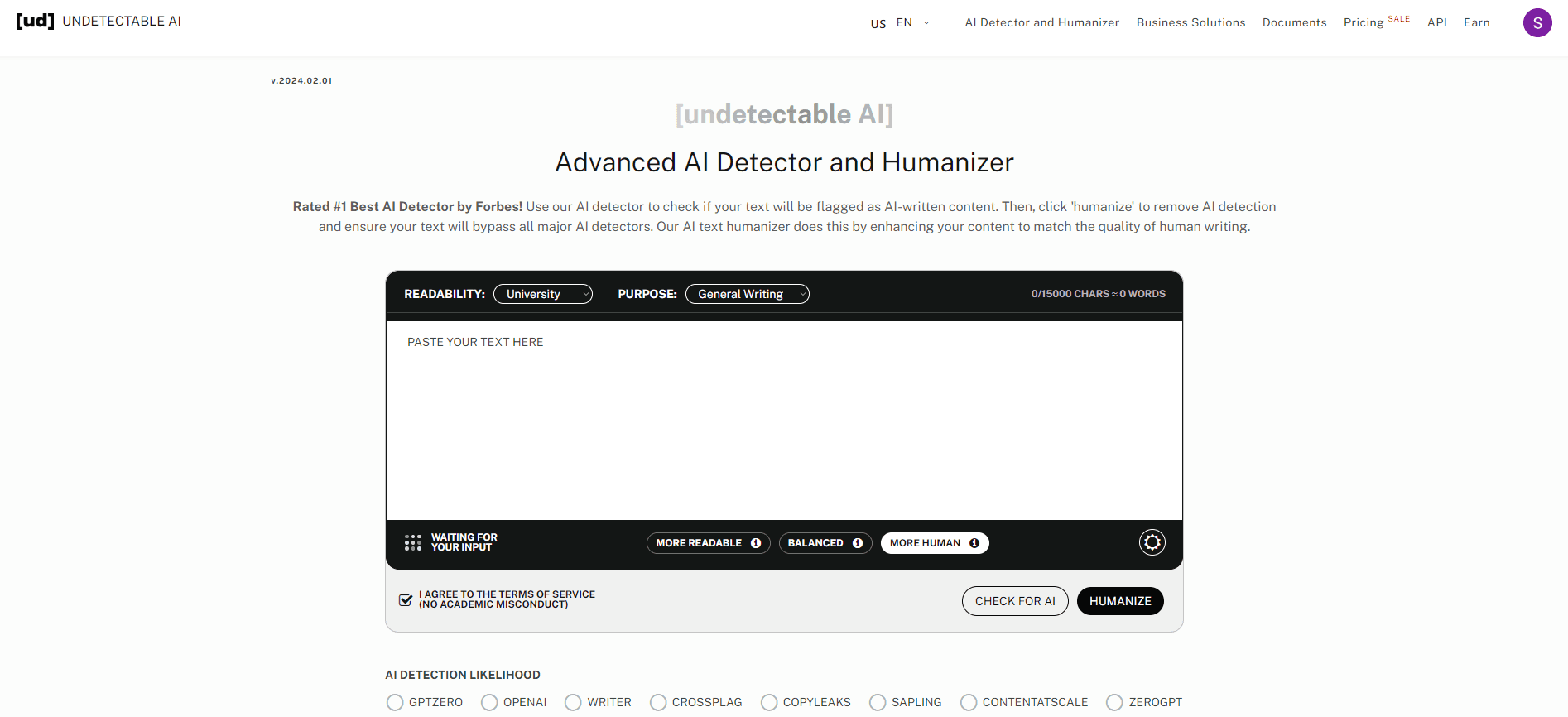
Undetectable AI represents a cutting-edge technology aimed at navigating the increasingly complex landscape of AI detection mechanisms, which are widely used to identify content generated by artificial intelligence. As educational institutions, publishing platforms, and various content management systems intensify their efforts to maintain the authenticity and integrity of human-generated content, Undetectable AI offers a solution for creators who wish to leverage AI's capabilities without being flagged by AI detectors. This technology is designed to refine AI-generated content in such a manner that it mimics the nuanced characteristics of human writing, thereby reducing the likelihood of detection. By employing advanced algorithms that adjust the style, tone, and syntax of the AI-generated text, Undetectable AI seeks to blend the efficiency and innovation of AI with the unique flair of human authorship.
The core promise of Undetectable AI lies in its ability to assure users that their AI-assisted content can pass through AI detection filters undetected. This is particularly appealing in scenarios where the use of AI for content creation is either restricted or could lead to penalties if discovered, such as in academic writing, professional reports, and creative works. The technology behind Undetectable AI is built on a deep understanding of the features that AI detectors typically target, and it fine-tunes the output to avoid these common pitfalls. It essentially provides a bridge between the powerful capabilities of AI in content generation and the necessity for content to retain a human touch. In doing so, Undetectable AI enables users to benefit from the best of both worlds, fostering a new era of content creation that is both innovative and indistinguishable from human-produced work, all while navigating the ethical considerations associated with AI-assisted content creation.
Understanding Undetectable AI
The technology behind Undetectable AI is rooted in sophisticated machine learning and natural language processing (NLP) techniques, which are designed to analyze and replicate the subtleties of human writing styles. At its core, Undetectable AI employs a series of algorithms that scrutinize the structural, stylistic, and linguistic patterns typical of human-generated content. By understanding these patterns, the technology can modify AI-generated text to more closely mimic human writing, adjusting factors such as syntax complexity, vocabulary diversity, and idiosyncratic expressions that are less common in machine-generated text. This involves a deep analysis of the content to identify and alter any telltale signs that could signal AI involvement, ensuring the output smoothly aligns with the nuances of natural human language.
The operation of Undetectable AI hinges on continuous learning from vast datasets of human-written text across various genres and fields, enabling it to stay updated with evolving language use and trends. This adaptability is crucial for bypassing AI detectors, which themselves are constantly being updated to catch new patterns indicative of AI use. Undetectable AI's algorithms are trained to not only avoid detection but also to enrich the content with the depth and creativity often associated with human insight. By integrating feedback loops into its processing, Undetectable AI dynamically refines its approach based on the success rate of bypassing detection mechanisms, ensuring it remains ahead of the curve. This blend of technology enables users to produce content that benefits from AI's efficiency and innovation while maintaining the authenticity and engagement of human-created works, offering a seamless solution for navigating the challenges posed by AI detection systems.
Features of Undetectable AI
Human-Like Content Generation: Uses algorithms to make AI text resemble human writing, focusing on grammar styles and tone variations. The ability to analyze and replicate the writing style of a specific author or a generic human writing pattern, making the AI-generated content appear more natural and less formulaic.
Enhanced Originality: Implements checks to ensure content uniqueness and reduce similarity, promoting trustworthiness online.
Customization Options: Allowing users to set specific parameters for content generation, such as target audience, formality level, and purpose, to better tailor the output to their needs.
AI Detection Evasion: Enables AI-generated content to bypass detection tools, useful for SEO and digital marketing. Offering predictive analysis to estimate the likelihood of the content being flagged by common AI detection tools, along with suggestions for further modifications.
User-Friendly Interface: Simplifies content creation with an easy-to-use interface, accessible to all skill levels.
Use our Free AI Detector to check your content
Integration Capability: The ability to integrate with popular content management systems, word processors, and educational platforms for seamless content creation and submission processes.
Testing Undetectable AI’s Capabilities
GPTZero is a tool designed to detect whether a piece of text was written by a human or generated by an AI, such as those based on GPT models. It aims to discern the authenticity of content by analyzing writing styles and patterns, offering insights into the originality of written works. This capability is particularly useful in educational settings for ensuring academic integrity and in content creation spaces to maintain authenticity and trustworthiness.
Undetectable AI has asserted its capability to circumvent GPTZero's detection mechanisms, presenting a challenge to the tool's ability to differentiate between human and AI-generated text. This claim sets the stage for an intriguing evaluation of Undetectable AI's effectiveness in bypassing one of the known AI detection tools, GPTZero. Testing this claim involves closely examining the nuances of text generated by Undetectable AI to see if it indeed can pass as human-written content when scrutinized by GPTZero's analytical framework.
In our test, we'll leverage ChatGPT to generate text, then use Undetectable AI to modify this output with the aim of evading detection by AI detectors like GPTZero. This experiment will assess Undetectable AI's proficiency in making AI-generated content appear indistinguishably human-like, challenging the detection capabilities of sophisticated tools designed to differentiate between human and machine-created text. This approach will provide a practical evaluation of Undetectable AI's claims about its AI bypassing capabilities.
We will use the output provided by ChatGPT and humanize it through Undetectable AI.
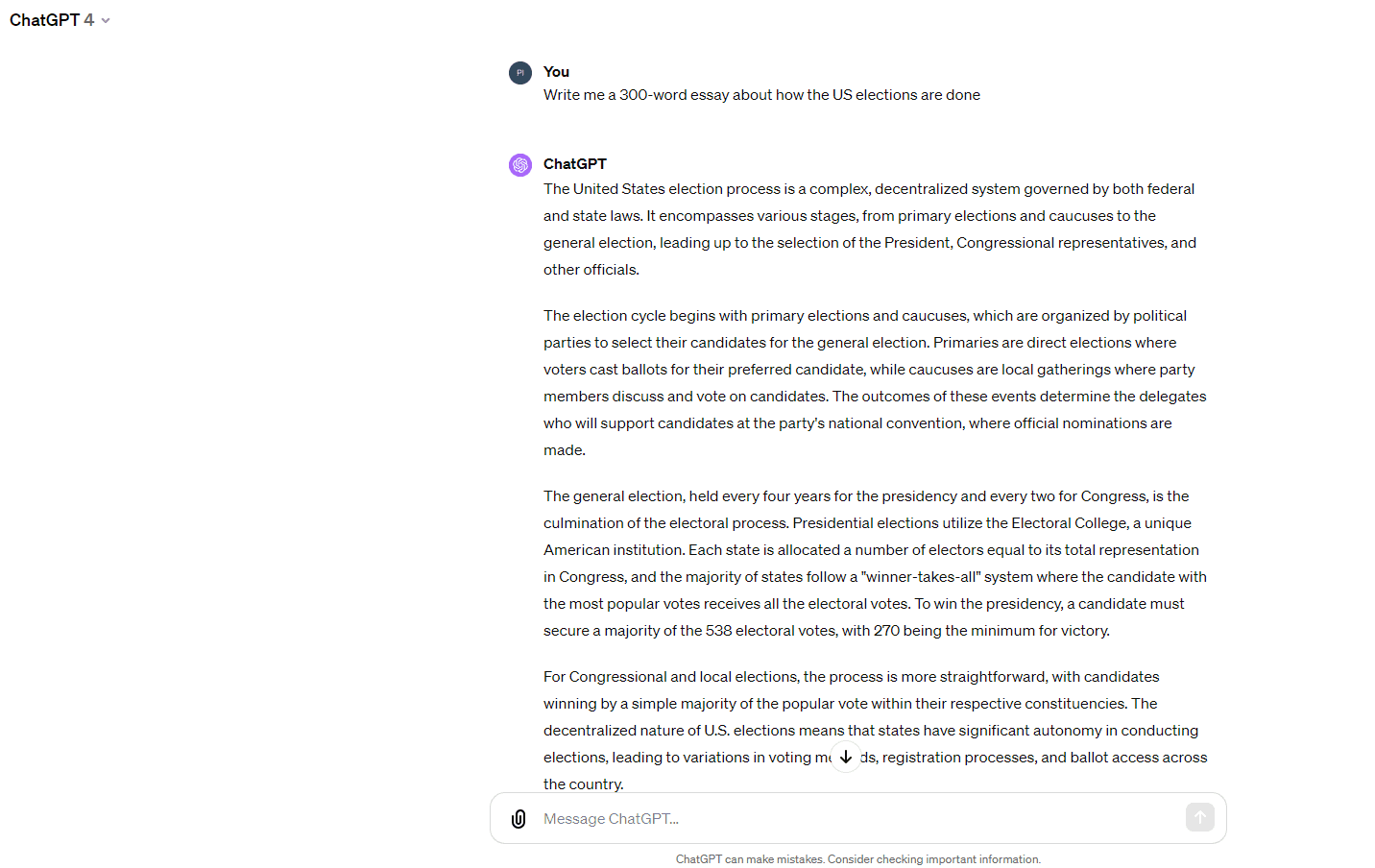
Here’s the output produced by Undetectable AI and now, let’s check how GPTZero scores this content.
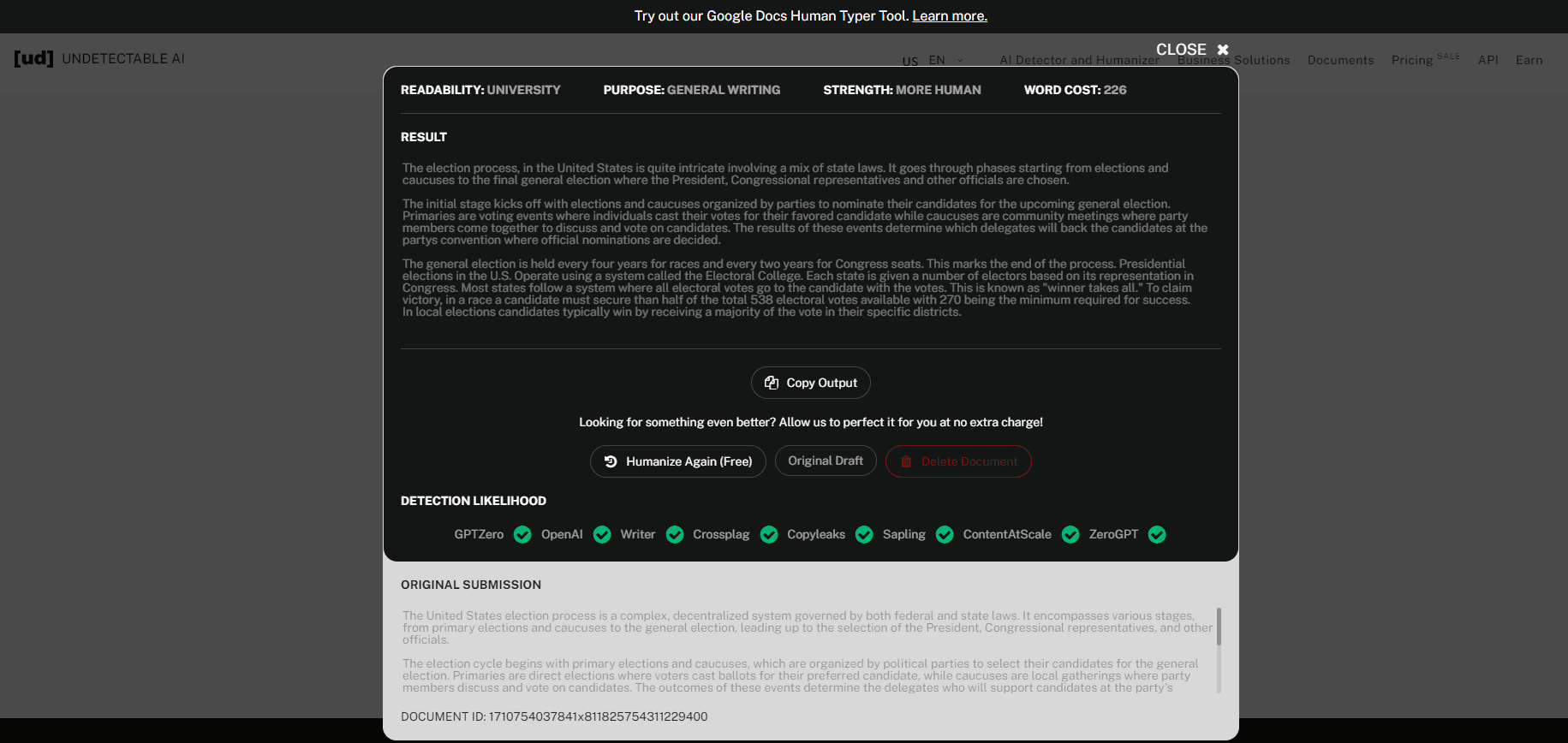
Undetectable AI vs GPTZero Results
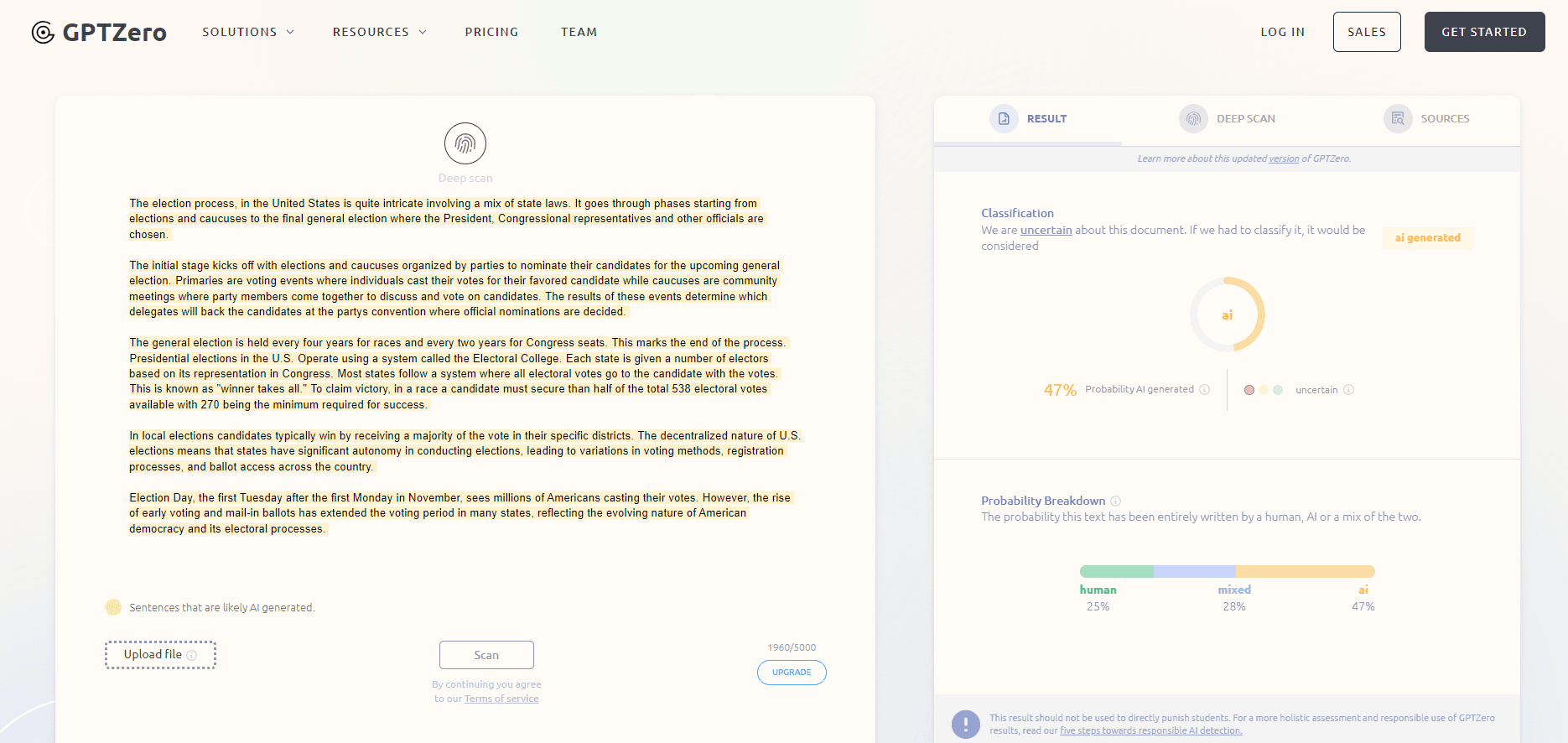
In a recent evaluation, we tested the capabilities of Undetectable AI, a service that claims to produce AI-generated text indistinguishable from human-written content, thus supposedly capable of bypassing detection tools like GPTZero. Contrary to its assertions, the text generated using Undetectable AI was flagged as AI-generated with a 47% AI-written score. This outcome directly challenges the platform's claim to offer a foolproof solution for creating undetectable AI-written content, raising questions about its efficacy and the reliability of its algorithms in mimicking human writing styles closely.
With a subscription fee of $14.99 per month, users of Undetectable AI anticipate a high level of performance that the platform promises—coherent, humanized written content that can evade detection by current AI detection tools. However, our test results reveal a significant shortfall in meeting these expectations. The failure to deliver on its promise not only undermines the value proposition offered to its users but also highlights the complexities and current limitations in generating AI text that can consistently pass as human-written, underscoring the need for continuous improvement and innovation in this field.
StealthGPT As a Worthy Opponent
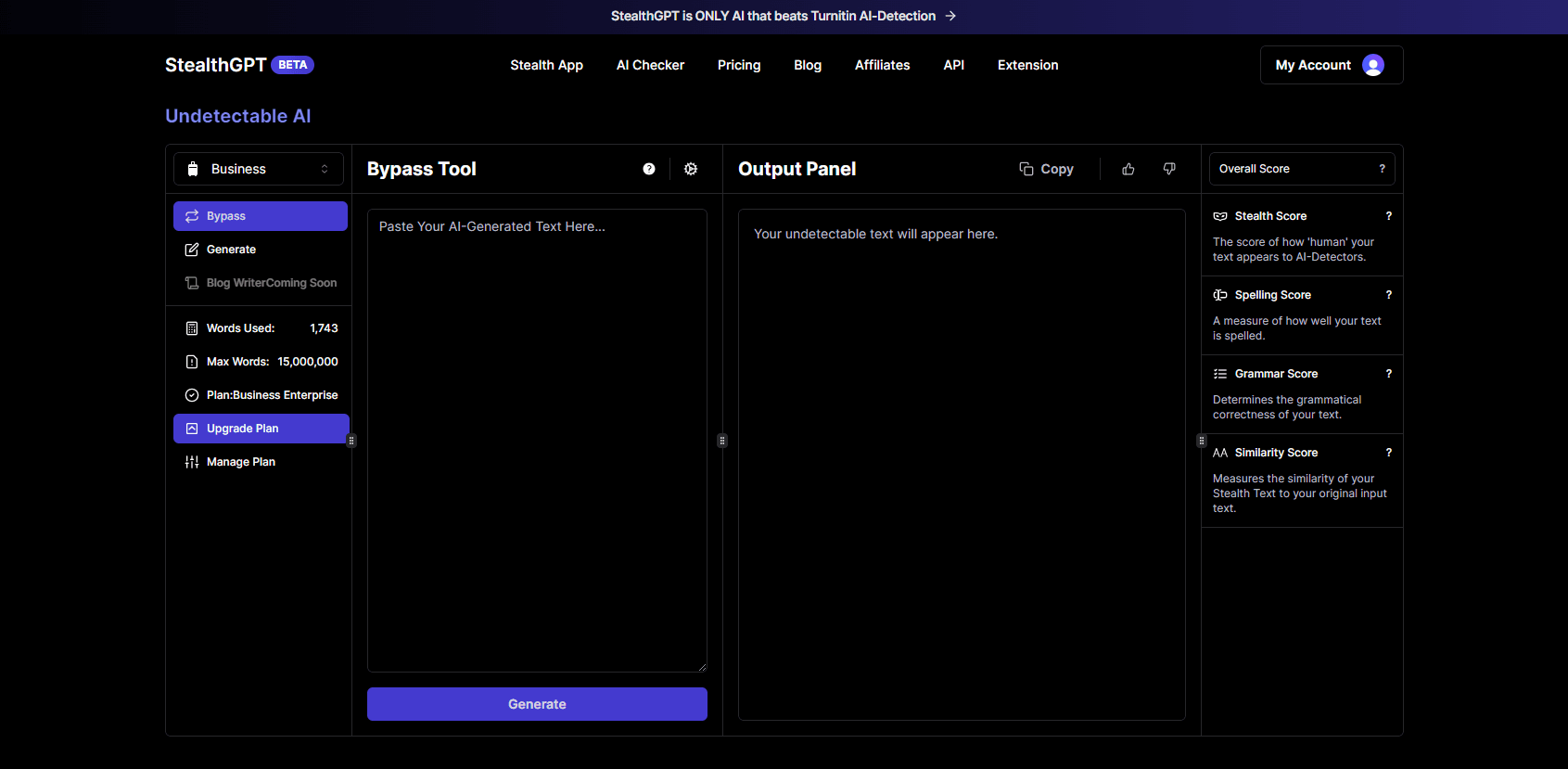
StealthGPT is emerging as a significant tool in the realm of AI-written content, offering innovative solutions for bypassing AI detection systems. It is a tool designed to modify AI-generated content in such a way that it becomes indistinguishable from content written by humans. It achieves this by altering various elements of the text, including syntax, style, and word choice, to evade detection by AI content detectors. This technology is particularly valuable in environments where the authenticity of human authorship is critical, offering a solution for seamlessly integrating AI assistance into content creation without being flagged by AI detection tools.
StealthGPT leverages the Generative Pre-trained Transformer architecture to produce undetectable AI-generated content. It's designed to generate text that closely mimics human writing by understanding context, adapting to various styles, and lacking discernible patterns that AI detectors look for. This makes it particularly challenging for traditional AI detection methods, such as linguistic analysis and pattern recognition, to identify content created by StealthGPT. Continuous improvements and ethical considerations ensure its responsible deployment, keeping it ahead of detection techniques and making it a powerful tool for creating seamless, human-like digital content.
In this section, we delve into the intriguing features of StealthGPT, examining its distinctive advantages over Undetectable AI and its emergence as a potent tool for bypassing GPTZero. We explore how StealthGPT's innovative algorithms and approaches enable it to seamlessly integrate with existing systems, providing users with enhanced capabilities while remaining under the radar of detection technologies. By comparing its functionalities with those of Undetectable AI, we highlight the unique aspects that make StealthGPT a preferred choice for users seeking to maintain the anonymity of their AI-generated content. Furthermore, we dissect its effectiveness in circumventing GPTZero's detection mechanisms, showcasing its utility in scenarios where the detection of AI-generated text is a concern. Through this comparison and analysis, we aim to provide a comprehensive understanding of StealthGPT's position in the evolving landscape of AI technologies.
Features of StealthGPT
Covert Content Creation: StealthGPT is strategically developed to produce content that easily avoids detection by anti-AI systems, enabling smooth incorporation of AI-crafted content on a wide array of platforms.
Advanced Language Processing: StealthGPT, equipped with a vast array of training data encompassing various styles and topics, employs advanced NLP techniques. This enables it to understand and produce text reflecting human-like expressions closely.
Mimicry of Human Writing Styles: The AI has the ability to modify its writing style and tone to suit a wide range of needs, seamlessly weaving in idiomatic expressions and variations of natural language.
Evasion of Detection: Employing pattern variation and content randomization strategies, StealthGPT successfully eludes detection by AI content detectors.
Customization and User Input: Users wield the power to tailor the tone, style, and format of the generated content, with the tool leveraging feedback to continually enhance its performance.
Wide Range of Applications: Versatility defines StealthGPT, making it suitable for content creation, SEO optimization, academic writing, idea generation, brainstorming, and business communication.
Putting StealthGPT to The Same Test
We will conduct the same rigorous test we did previously with Undetectable AI with StealthGPT to assess its prowess in evading GPTZero's detection capabilities. This examination aims to validate the effectiveness of StealthGPT in bypassing AI detectors, providing a practical demonstration of its claims. Through this test, we intend to explore the adaptability and sophistication of StealthGPT's technology in producing content that seamlessly passes as human-generated, under the scrutiny of advanced AI detection tools like GPTZero.
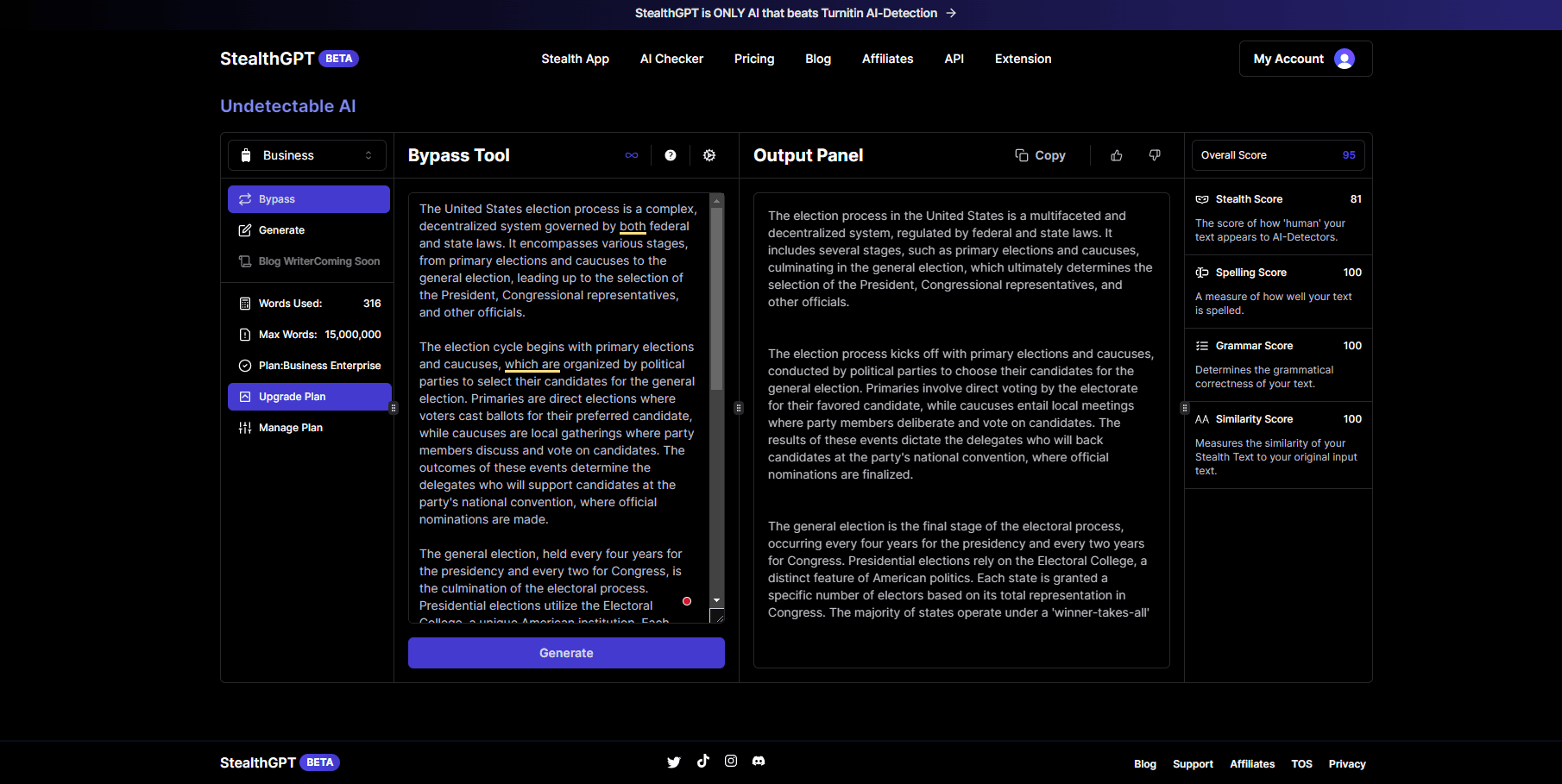
We have taken the same ChatGPT output and put that through StealthGPT’s bypass tool.
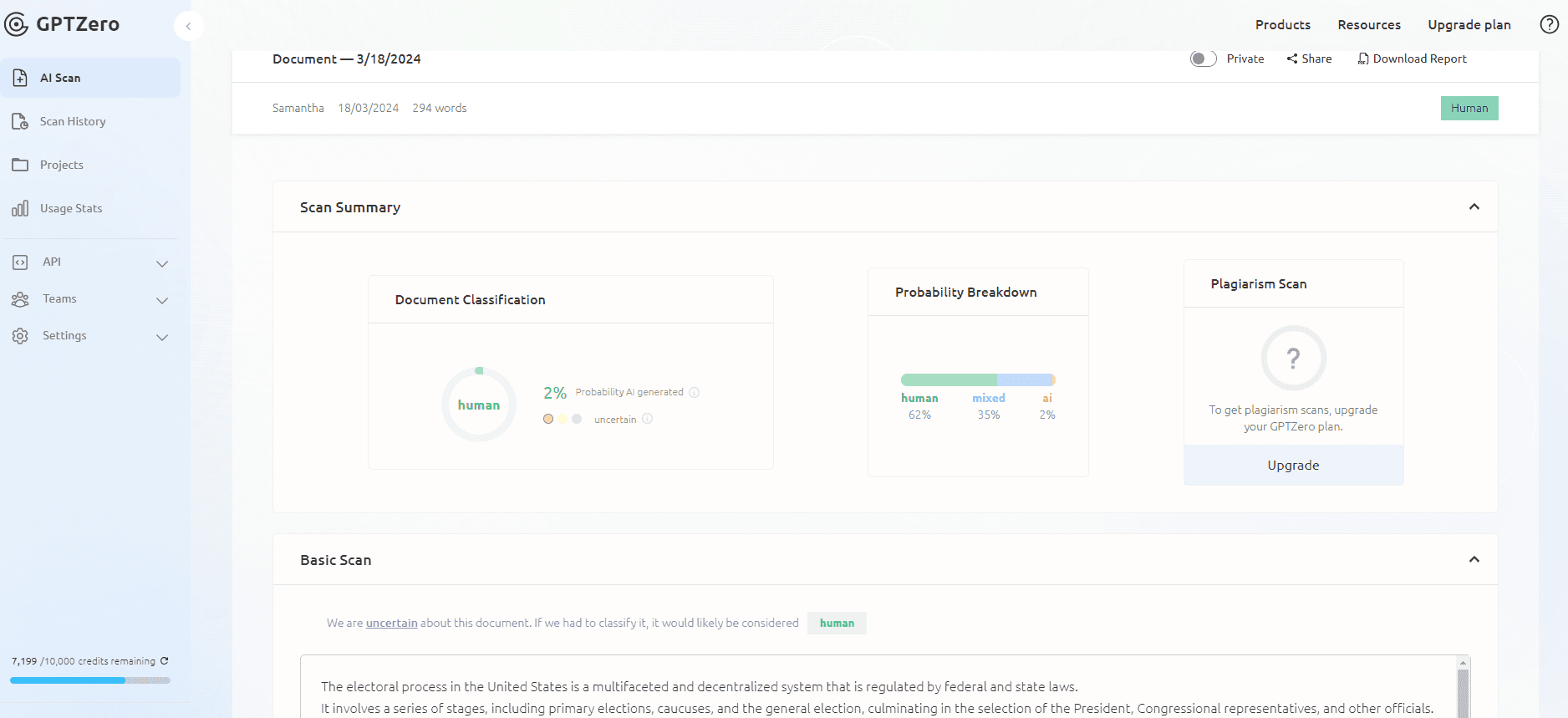
The results were remarkable, with the content produced by StealthGPT achieving a mere 2% probability of being AI-generated according to GPTZero's analysis. This low score not only demonstrates StealthGPT's exceptional capability in mimicking human writing styles but also validates its effectiveness in circumventing AI detection mechanisms, living up to its claims of producing content that closely resembles human writing.
The success of StealthGPT in this test underscores its reliability and the value it offers to its users, who seek to create AI-generated content that can pass as human-written. By ensuring that its output is virtually undetectable by current standards of AI detection software, StealthGPT delivers on its promise, providing a powerful tool for users who require content that maintains the authenticity and subtlety of the human touch. This achievement highlights StealthGPT's advanced technology and its potential to revolutionize the way AI-generated content is perceived and utilized, marking a significant milestone in the evolution of AI writing tools.
Conclusion
Artificial Intelligence (AI) has significantly transformed the content creation landscape, offering tools that aid writers in generating ideas, drafting articles, and even refining grammar and style. These AI writing aids can dramatically increase productivity, helping to overcome writer's block and streamline the editing process. However, with the rise of AI in content creation, there's been an increasing need for AI bypass tools. Such tools are designed to make AI-generated content appear more human-like, reducing the likelihood of detection by AI-detection software. This is particularly valuable for content creators who wish to maintain the authenticity and originality of their work without the stigma often associated with AI-generated content.
StealthGPT emerges as a frontrunner in this arena, offering groundbreaking technology that produces content virtually indistinguishable from that written by humans. By successfully reducing AI detection probabilities to near zero, StealthGPT has proven its capability to deliver on its promises. Its sophisticated algorithms ensure that the content not only reads naturally but also carries the nuances and complexities of human thought processes, making it a valuable asset for anyone looking to generate high-quality, humanized content. The tool's success in bypassing AI detectors like GPTZero with remarkable efficiency has garnered well-deserved recognition, highlighting its role as a game-changer in the realm of AI-assisted content creation.
For those seeking to leverage the power of AI in their writing endeavors without the concern of their content being flagged as AI-generated, StealthGPT presents an ideal solution. Its proven effectiveness and ability to deliver authentically humanized content offer a new level of confidence and freedom in content creation. By choosing StealthGPT, users can focus on the creative aspects of their work, assured that the output will meet the highest standards of originality and human-like quality. This encouragement to try StealthGPT is an invitation to step into a world where AI and human creativity coalesce seamlessly, free from the worries of content detection and limitations.
